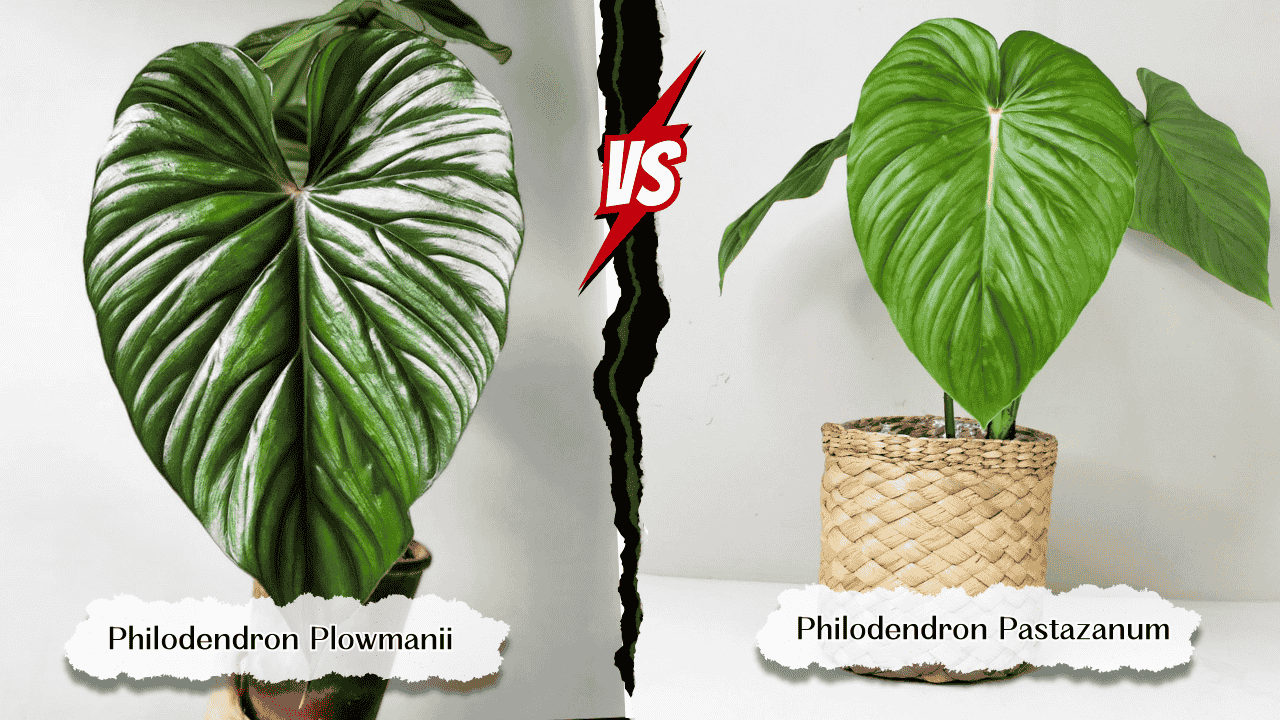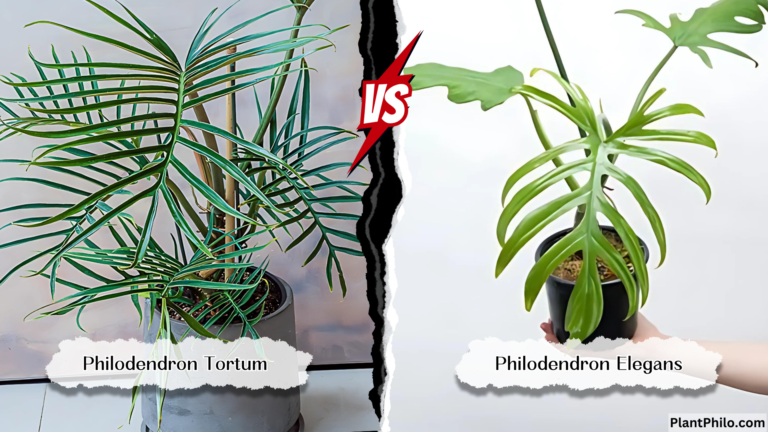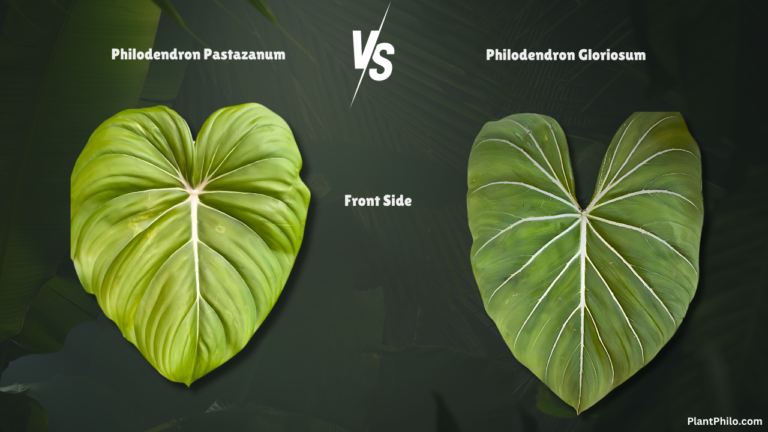Philodendron Pastazanum vs. Plowmanii: Explaining Key Differences (Part 1)
Philodendron doppelgangers? These two lush lovelies, Pastazanum and Plowmanii, have the plant world playing a game of “Who’s Who?” Don’t be fooled by their leafy disguises. Beneath their emerald exteriors lie subtle secrets that could make or break your plant parenting dreams.
When it comes to Philodendrons, there are few who can choose between two of the most beautiful varieties: a Philodendron Pastazanum and a Philodendron Plowmanii. They both have large heart-shaped leaves that attract any indoor plant enthusiast. But the distinctions in leaf texture and color are so subtle that it becomes difficult to tell them apart.
The Philodendron Pastazanum has matte green velvet leaves with lighter veins while the latter has deeper green foliage with dark midribs. Each of these plants also has its own unique appeal as well as care requirements which make growing them a rewarding experience altogether.
| Feature | Philodendron Pastazanum | Philodendron Plowmanii |
| Leaf Shape | Deeply lobed, “spidery,” wider at the base | Shallower lobes, rounder, more heart-shaped |
| Leaf Size | Up to 18+ inches | 8-12 inches (up to 15) |
| Leaf Texture | Glossy, smooth, sometimes bullate (bumpy) between veins | Matte, slightly textured, often with wavy edges |
| Petiole | Shorter, reddish-brown | Longer, green with prominent reddish base |
| Stem Color | Green to light brown | Green, sometimes reddish |
| Growth Habit | Creeping, semi-climbing, new leaves emerge from the soil | More upright, climbing, new leaves emerge from the stem tip |
| Soil | Well-draining aroid mix (peat moss, perlite, orchid bark) | Well-draining aroid mix (peat moss, perlite, orchid bark) |
| Temperature | 65°F-85°F (18°C-29°C) | 65°F-85°F (18°C-29°C) |
| Humidity | High (60-80%) | High (60-80%) |
| pH Level | 5.0-7.0 | 5.0-7.0 |
| Care Notes | May be sensitive to overwatering, fertilize regularly during growing season | More tolerant of occasional under-watering, fertilize regularly during growing season |
| Rarity & Price | Rare, expensive | Relatively rare, can be expensive |
Understanding the leaf types, growth habits, and care needs of these plants is crucial in selecting the right one for your home. By equipping yourself with this knowledge, you can confidently identify and care for these gorgeous philodendrons, ensuring their health and beauty in your indoor garden.
Key Takeaways
- Plowmanii’s leaves are dark and textured, whereas pastanzaums’ are velvety and matte.
- Both prefer bright indirect light & well-drained soil.
- Watch out for petiole color differences along with growth habits to distinguish between different kinds of philodendrons.
Taxonomic Breakdown
The Araceae family is well known for their striking foliage plants which include both species – Philodendron pastanzanum & plowmanii.
Scientific Classification:
- Kingdom: Plantae
- Order: Alismatales
- Family: Araceae
- Genus: Philodendron
Philodendron Pastazanum
- Species Name: Philodendron pastazanum
- Native Habitat: Found in the rainforests of Ecuador, it thrives in humid, shaded environments.
- Growth Habits: A semi-climbing or creeping plant known for its large, heart-shaped leaves.
Philodendron Plowmanii
- Species Name: Philodendron plowmanii
- Native Habitat: It is native to the tropical rainforests of Peru and Brazil, where it prefers moist shady areas.
- Growth Habits: This, too, is a creeping plant but with slightly more robust growth compared to pastazanum, which tends to be less vigorous in habit.
Knowing this classification and habitat will help you care better for these beautiful plants as well as appreciate their different features. If you need more detailed information, here is a guide on Philodendron plowmanii care.
In-Depth Look at the Leaves
Let’s take an in-depth look at the leaves of both Philodendron Pastanzanum and Plowmanii. Each plant has unique leaf features that contribute to their overall attractiveness. We’ll explore these features in the following sub-sections, helping you to understand what sets each foliage apart from its counterpart.
Both Philodendron Pastanzanum and Plowmanii have unique leaf features which make them very attractive plants. The following sub-sections should help you understand what sets each foliage apart from its counterpart.
Shape
Philodendron pastazanum leaves are deeply dissected with prominent well-defined often acute lobes giving them more of an irregular or ‘spidery’ appearance due to separation between lobes along leaf blade margin.
Philodendron plowmanii leaves also possess lobes however they’re shallower and rounder than those found on pastanzaums’. They tend to have broader heart-shaped bases or ovals making them look compact especially when compared side by side with pastazanum’s leaf shape which shows greater variability in base width across different individuals (i.e., wider at apex).
Size
Generally, philodendra pastanzanums produce larger leaves that can grow up to 18 inches or more in length. This makes them quite imposing houseplants if grown under optimal conditions such as high humidity levels and ample lighting throughout the day.
On average, plowmanniis’ leaves are smaller, ranging from about 8 – 12 inches, although some may reach up to 15 inches long. When placed next to each other, one can easily notice this difference in size between the two species.
Surface Texture
Philodendron pastazanum leaves are shiny and smooth with a glossy appearance on their upper surface. They have an intense green color which makes them look very elegant when used for interior decoration purposes.
On the contrary, plowmanii’s leaves do possess some amount of gloss but not as much as that seen in pastanzaums’. Sometimes, they may exhibit slight undulation along the leaf margins, giving rise to wavy-looking edges, which adds to the overall textural complexity of this plant type.
Venation
These leaves have prominent lighter green or yellow veins that run throughout them, whether they belong to Philodendron Pastazanum or Plowmanii. In contrast with the dark green surface of the leaf, these veins make for an attractive display.
The veins in Philodendron Pastazanum may be slightly more pronounced due to its deeper leaf dissection, which can create a complex patchwork-like pattern on the leaf that is visually striking.
Stems
Philodendrons have green or light brown stems that are relatively thin and Viney in growth habit; this allows them to appear delicate while being able to trail up or climb.
Philodendron plowmanii’s stem can also be green but sometimes it appears a little bit thicker than philodendron pastazanum making it look strong enough to support its abundant foliage.
Petioles
The petioles (leaf stalks) of Philodendron Pastazanum are typically shorter and redder than those of Plowmanii. This gives the plant a compact appearance.
For Philodendrons plowmanii, its petioles are also greenish; however, they tend to have more pronounced reddish tinges, especially closer towards their bases; moreover, these petioles are usually longer than those of pastazanums thus giving room between adjacent leaves greater than pastazans do, among themselves.
Growth Habit and Care Requirements
Both philodendron pastazanums as well as philodendon plowmanniis would make wonderful additions into any indoor garden! Knowing how these plants grow best & what they need most when under your care is key!
Growth Pattern
Philodenron pastazanum crawls along the ground steadily growing; it has a rhizome that spreads horizontally providing sturdy support for large leaves whereas the other grows upwards like a moss pole or trellis up to 6 feet tall with help from climbing companion plants such as moss poles etc., this allows them reach higher heights easily.
Plowmanii tends to have a more upright growth habit and larger leaves growing at the top. When planning your space, consider these differing growth habits.
Light
Both Philodendron Pastazanum and Philoden plaumanii prefer bright indirect light. Direct sunlight will scorch the leaves, causing damage. It is recommended to place them near a window where there’s plenty of light, but avoid direct sunlight hitting their leaves.
If your home lacks natural lighting, grow lights can be used. These plants need consistent lighting for healthy growth.
Watering
The watering requirements of these two philodendrons are similar; it is essential to let the top inch of soil dry out before watering again, as this prevents root rot, which is common with overwatering.
Check with your finger for moisture level in soil, do not let plants sit in water; well-draining soil & pots having drainage holes are necessary for healthy roots.
Soil
A well-draining aroid mix makes both plants thrive; an example blend would include orchid bark, perlite and peat moss that provide adequate aeration and drainage needed by these plants.
Regularly examine the soil & repot every 1-2 years if necessary, freshening up the soil increases nutrient levels thus keeping your plant healthier.
Additional Notes
Philodendron pastazanum might take longer to grow compared with plowmanii. So be patient when growing pastazanums they have steady growth rate that may take some time to mature . On the other hand plowmanii might tolerate erratic watering better making it slightly less demanding for novice growers than most other philodenrons .
Both these plants have the same requirement of additional feeding in their growing season. Give them diluted and balanced fertilizer every month for dense foliage. In winter, when growth slows down naturally, do not fertilize them. If you keep this in mind, your Philodendrons will thrive.
Identification Tips for Uncertain Plant Parents
There are distinct characteristics of Philodendron Pastazanum and Plowmanii that can help in their identification. The shape, size, and texture of the leaves, as well as the color and length of petioles, show notable variation between them.
Leaf Shape
Observe the leaf structure when identifying these plants. Philodendron Pastazanum has deep lobes that are well-defined and often pointed. This makes its leaves look more structured with an almost ‘spidery’ appearance due to separation at lobe points.
Philodendron Plowmanii, on the other hand, has shallower lobes that are rounder in shape. They usually have a heart-shaped or oval base, making them look softer compared to pastazanum, which appears angular.
Leaf Size
Another important aspect is leaf size. The leaves of Philodendron Pastazanum can grow up to 18 inches long or even more than that sometimes; therefore, they are bigger in comparison with other species, hence hard to ignore.
While some varieties may reach 15 inches, most commonly plowmanii have smaller sized leaves ranging between 8-12 inches approximately. Therefore considering leaf sizes could be helpful when differentiating these two plants from each other.
Petiole Color and Length
The stalks of leaves also provide hints about their identity, known as petioles. Petioles of philodendrons pastazanums are greenish or slightly reddish, having shorter lengths than those found on plowmaniis, where they could appear longer and with more pronounced redness, especially nearer to the base region. This gives them a uniform appearance with stems.
Leaf Texture
Texture of leaf surfaces is another distinguishing factor. The leaves of Philodendron Pastazanum are smooth and shiny with a glossy finish which feels almost velvety when touched; giving it vibrant look.
Plowmanii leaves however appear more matt than this hence lacking shine also having slight wavy edges along their margins thereby making them less lustrous but still attractive in its own way.
Frequently Asked Questions
These two species namely philodendron pastazanums and plowmaniis are gorgeous indoor plants that can sometimes be difficult to differentiate. This segment provides answers for some common queries related to identification and care of these houseplants.
How can I tell apart a Philodendron Pastazanum and a Philodendron Plowmanii?
Look at the leaves in order to distinguish between these two types of philodendrons. Those belonging to the former category usually have larger sizes, deeper lobes, and shininess due to their glossy texture. Conversely, varieties under the latter group possess heart-shaped structures with less pronounced lobation, and they are duller because they lack glossiness on surface areas.
What are the growth habits of Philodendron Plowmanii compared to Pastazanum?
Compared to pastazanums, plowmen tend to grow at relatively faster rates, thus requiring greater support, such as moss poles, since both are climbers. On occasions when watering could be erratic, plowmanii might prove more adaptable.
What are the key identifying features of a Philodendron Plowmanii?
Typical features associated with this particular variety include smallness in all dimensions (leaves, etc.) relative to not only pastazanums but also other types.
Also, petioles may exhibit longer lengths coupled by reddish tinges closer toward bases, leaf shapes tending to have roundedness rather than sharpness, as seen among some other species.
In what ways does a Philodendron Gloriosum differ from a Pastazanum?
The leaves of Philodendron Gloriosum have a soft texture with white veins that stand out, whereas those of Pastazanum are glossy and smooth, with less pronounced veins. Moreover, Gloriosum grows like a creeper rather than as a climber.
What are the care requirements for Philodendron Plowmanii?
You should place Philodendron Plowmanii in bright indirect light but not direct sun. Water it when the top inch of soil feels dry to the touch. Maintain high humidity around the plant and use well-draining soil mix while potting so that it can grow well.
Can you describe the foliage differences between Pastazanum and Plowmanii philodendrons?
Philodendron Pastazanum has large shiny deeply lobed leaves. On the other hand philodendron plowmanii features small heart shaped matte textured leaves that may have slightly wavy edges too.



